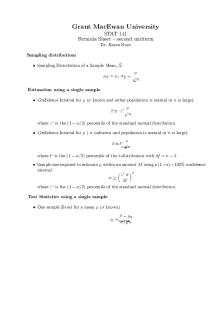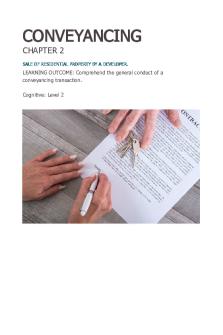Challs Stages - Lecture notes 2 PDF

| Title | Challs Stages - Lecture notes 2 |
|---|---|
| Course | Emergent Literacy Development |
| Institution | Texas A&M University |
| Pages | 1 |
| File Size | 68.1 KB |
| File Type | |
| Total Downloads | 20 |
| Total Views | 149 |
Summary
Chall's Stages notes...
Description
Chall’s'Stages'of'Reading'Development' Source:'Jeanne'S.'Chall,'Stages'of'Reading'Development.'N.Y.:'McGrawBHill'Book'Company,'1983.'
' Stage'
Approximate'
Characteristics'and'Masteries'
Age/Grade'
by'End'of'Stage'
Stage&0:&Pre+reading&
6&months&–&6&years&
“pseudo&reading”&
Preschool&
Stage&1:&Initial&reading&
6&–&7&years&old&
and&decoding&
1st&grade&and&beginning&2nd&
Stage&2:&Confirmation&
7&–&8&years&old&
and&fluency&
2nd&and&3rd&grade&
Stage&3:&&
9&+&13&years&old&
Reading&for&learning&the&
4th&–&8th&grade&
new&
&
&
Intermediate&4th&–&6th&
Phase&A&
&
&
Junior&high&school&7th&–&9th&&
Child&“pretends”&to&read,&retells&story& when&looking&at&pages&of&book& previously&read&to&him/her,&names& letters&of&alphabet;&recognizes&some& signs;&prints&own&name;&plays&with& books,&pencils&and&paper.& Child&learns&relation&between&letters& and&sounds&and&between&printed&and& spoken&words;&child&is&able&to&read& simple&text&containing&high&frequency& words&and&phonically®ular&words;& uses&skill&and&insight&to&“sound&out”& new&one&syllable&words.&&
Child&reads&simple,&familiar&stories& and&selections&with&increasing& fluency.&This&is&done&by&consolidating& the&basic&decoding&elements,&sight& vocabulary,&and&meaning&context&in& the&reading&of&familiar&stories&and& selections.&& Reading&is&used&to&learn&new&ideas,&to& gain&new&knowledge,&to&experience& new&feelings,&to&learn&new&attitudes,& generally&from&one&viewpoint.&
Phase&B& Stage&4:&&
15&–&17&years&old&
&&&Multiple&viewpoints&
10th&–&12th&grade&
&Stage&5:&&
18+&years&old&
&Construction&and&&&&&&&&&&&&&&&&&&&&& College&and&beyond& &&reconstruction& &&&&&&&&&&&&&&&&&&&&&&&&&&&&&&&&&&&&&&&&&&&&
Reading&widely&from&a&broad&range&of& complex&materials,&both&expository& and&narrative,&with&a&variety&of& viewpoints.&&
Reading&is&used&for&one’s&own&needs& and&purposes&(professional&and& personal);&reading&serves&to&integrate& one’s&knowledge&with&that&of&others,& to&synthesize&it&and&to&create&new& knowledge.&It&is&rapid&and&efficient.&&
How'Acquired'
Relationship'of'Reading'to'Listening'
Being&read&to&by&an&adult&(or&older& child)&who&responds&to&and&warmly& appreciates&the&child’s&interest&in& books&and&reading;&being&provided& with&books,&paper,&pencils,&blocks,&and& letters.&Dialogic&reading.& Direct&instruction&in&letter+sound& relations&(phonics)&and&practice&in& their&use.&Reading&of&simple&stories& using&words&with&phonic&elements& taught&and&words&of&high&frequency.& Being&read&to&on&a&level&above&what&a& child&can&read&independently&to& develop&more&advanced&language& patterns,&vocabulary&and&concepts.& Direct&instruction&in&advanced& decoding&skills;&wide&reading& (instruction&and&independent&levels)& of&familiar,&interesting&materials&that& help&promote&fluent&reading.&Being& read&to&at&levels&above&their&own& independent&reading&level&to&develop& language,&vocabulary&and&concepts.&& Reading&and&study&of&textbooks,& reference&works,&trade&books,& newspapers,&and&magazines&that& contain&new&ideas&and&values,& unfamiliar&vocabulary&and&syntax;& systematic&study&of&words&and& reacting&to&the&text&through& discussion,&answering&questions,& writing,&etc.&Reading&of&increasingly& more&complex&text.&& Wide&reading&and&study&of&the& physical,&biological&and&social&sciences& and&the&humanities,&high&quality&and& popular&literature,&newspapers,&and& magazines;&systematic&study&of&words& and&word&parts.& Wide&reading&of&ever&more&difficult& materials,&reading&beyond&one’s& immediate&needs;&writing&of&papers,& tests,&essays,&and&other&forms&that&call& for&integration&of&varied&knowledge& and&points&of&view.&&
Most&can&understand&the&children’s&picture&books& and&stories&read&to&them.&They&understand& thousands&of&words&they&hear&by&age&6&but&can&read& few&if&any&of&them.&
The&level&of&difficulty&of&language&read&by&the&child& is&much&below&the&language&understood&when& heard.&At&the&end&of&Stage&1,&most&children&can& understand&up&to&4000&or&more&words&when&heard& but&can&read&about&600.&
At&the&end&of&Stage&2,&about&3000&words&can&be&read& and&understood&and&about&9000&are&known&when& heard.&Listening&is&still&more&effective&than&reading.&&
At&beginning&of&Stage&3,&listening&comprehension&of& the&same&material&is&still&more&effective&than& reading&comprehension.&& & By&the&end&of&Stage&3,&reading&and&listening&are& about&equal&for&those&who&read&very&well,&reading& may&be&more&efficient.&&
Reading&comprehension&is&better&than&listening& comprehension&of&materials&of&difficult&content&and& readability.&For&poor&readers&listening& comprehension&may&be&equal&to&reading& comprehension.& Reading&is&more&efficient&than&listening.&&...
Similar Free PDFs

Challs Stages - Lecture notes 2
- 1 Pages

Stages of Infection - notes
- 2 Pages

Lecture notes, lecture 2
- 3 Pages

2 - Lecture notes 2
- 5 Pages

Lecture notes, lecture Chapter 2
- 11 Pages

Lecture notes, lecture formula 2
- 1 Pages

2 Biodiversity - Lecture notes 2
- 33 Pages

Chapter 2 - Lecture notes 2
- 30 Pages
Popular Institutions
- Tinajero National High School - Annex
- Politeknik Caltex Riau
- Yokohama City University
- SGT University
- University of Al-Qadisiyah
- Divine Word College of Vigan
- Techniek College Rotterdam
- Universidade de Santiago
- Universiti Teknologi MARA Cawangan Johor Kampus Pasir Gudang
- Poltekkes Kemenkes Yogyakarta
- Baguio City National High School
- Colegio san marcos
- preparatoria uno
- Centro de Bachillerato Tecnológico Industrial y de Servicios No. 107
- Dalian Maritime University
- Quang Trung Secondary School
- Colegio Tecnológico en Informática
- Corporación Regional de Educación Superior
- Grupo CEDVA
- Dar Al Uloom University
- Centro de Estudios Preuniversitarios de la Universidad Nacional de Ingeniería
- 上智大学
- Aakash International School, Nuna Majara
- San Felipe Neri Catholic School
- Kang Chiao International School - New Taipei City
- Misamis Occidental National High School
- Institución Educativa Escuela Normal Juan Ladrilleros
- Kolehiyo ng Pantukan
- Batanes State College
- Instituto Continental
- Sekolah Menengah Kejuruan Kesehatan Kaltara (Tarakan)
- Colegio de La Inmaculada Concepcion - Cebu







